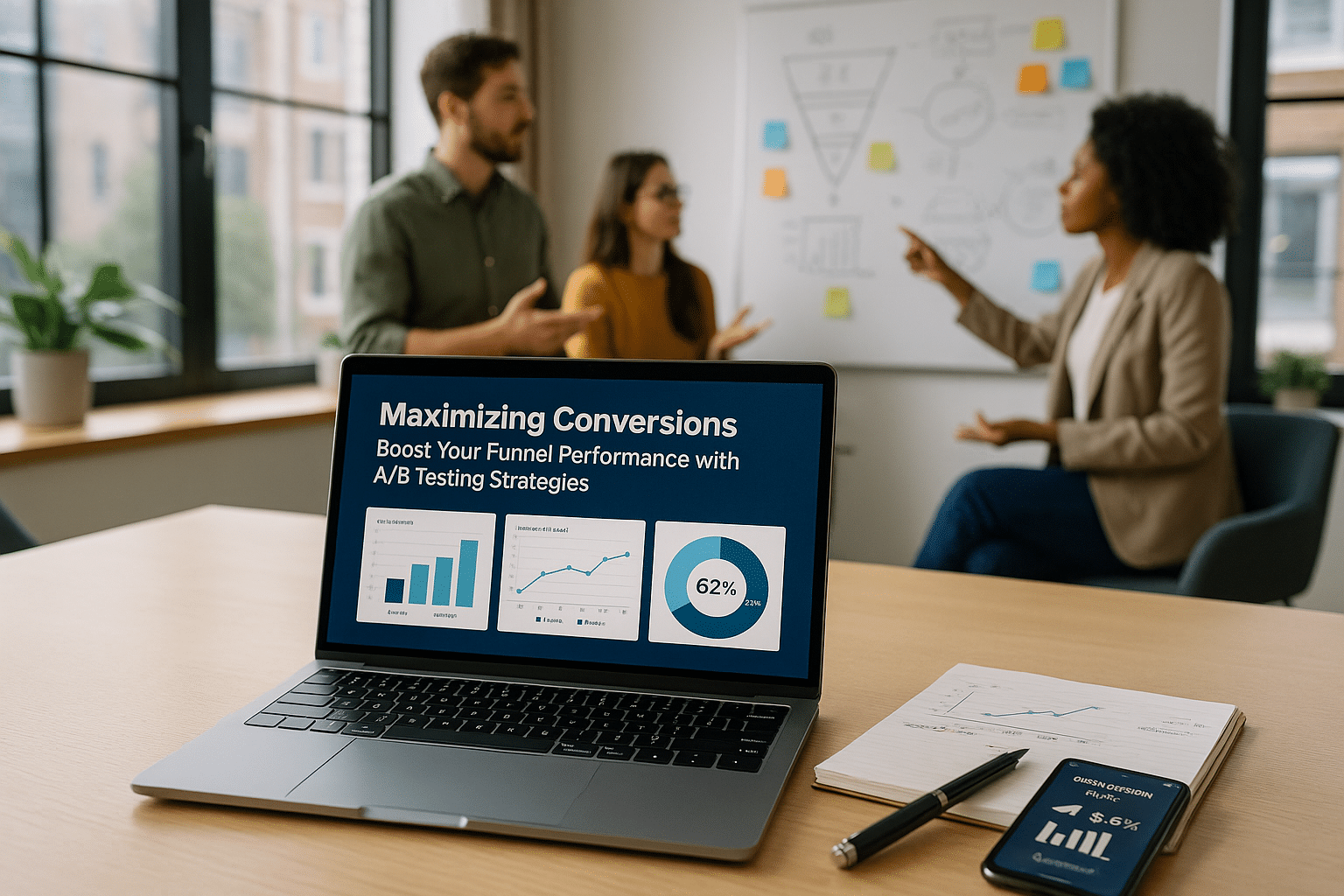The secret lies in the power of A/B Testing strategies. 🎯 In the fascinating and ever-evolving world of digital marketing, the race to get better conversion rates never ends. The winning trophy? Higher ROI and a robust digital presence that outperforms your competitors.
But how do we achieve this coveted victory? Simple: through experimentation, analysis, and fine-tuning. And that’s precisely what A/B Testing allows us to do.
Often overlooked by many, A/B Testing is a powerful strategy that can dramatically improve your conversion rates and overall funnel performance. 💪 Still, to harness its full potential, it’s crucial to understand what it is, how it works, and the best practices for implementing it effectively. If you’ve been seeking this knowledge, you’ve come to the right place.
🚀 Buckle Up for A Deep Dive into A/B Testing Strategies!
This comprehensive guide will empower you with practical knowledge and actionable insights to leverage A/B testing in your digital marketing arsenal. By the end, you’ll have a clear roadmap to boost your conversions, optimize your funnel performance, and scale your online presence to new heights. 📈
Let’s get a sneak peek of what’s in store for you:
- Demystifying A/B Testing: We’ll shed light on what A/B testing is, how it works, and why it’s critical for your digital marketing strategy.
- Designing Effective A/B Tests: Learn the art of crafting effective A/B tests that yield meaningful insights and tangible results.
- Interpreting A/B Test Results: We’ll guide you on how to interpret the results of your A/B tests, make sense of the data, and make informed decisions.
- A/B Testing Best Practices: Discover the industry’s best practices and proven strategies to take your A/B testing game to the next level.
Whether you’re a seasoned digital marketer or a newbie dipping your toes in the waters of online marketing, this guide will equip you with the necessary skills and knowledge to master A/B testing. 👨🎓👩🎓
💼 Why Should You Care about A/B Testing?
In the modern digital landscape, decision-making based on hunches or assumptions is a dangerous game. Instead, data-driven decisions are the way to go. A/B Testing serves as a reliable, data-backed method to understand your audience better, validate your marketing hypotheses, and optimize your conversion funnel.
Think about it this way: A/B Testing is like a GPS that guides you through the maze of digital marketing, ensuring you’re on the right track. Without it, you might be driving blindfolded, risking your time, effort, and resources.
🔍 Ready to Unravel the Power of A/B Testing?
So, are you ready to delve into the fascinating world of A/B Testing and discover how it can turbocharge your conversion rates and funnel performance? Stay tuned as we unravel the mysteries of A/B Testing, explore its potential, and arm you with strategies that will leave your competitors wondering what hit them! 🎢
The world of A/B Testing is waiting. Let’s dive in! 🏊♂️
Introduction to A/B Testing: The Power of Experimentation
One of the most powerful tools in your digital marketing toolkit is A/B testing. 🛠️ This data-driven approach allows you to maximize conversions by comparing two versions of your website or marketing assets to see which one performs better. This way, you can make decisions based on actual user behavior, rather than guesswork.
According to a video by Google Analytics titled “A/B Testing: Make Better Decisions with Data” (via YouTube), A/B testing allows you to take the guesswork out of website optimization and enables data-informed decisions that shift business conversations from “we think” to “we know.” A/B testing is a method of comparing two versions of a webpage or other user experience to determine which one performs better. It is a way to validate that any new design or change to an element on your webpage is improving your conversion rate.
In essence, A/B testing can be a game-changer for your conversion optimization strategy, enabling you to continuously improve your online performance. 👏 But, how do you start implementing A/B testing strategies? What tools and techniques do you need? And how can you ensure your tests deliver meaningful insights?
A/B Testing 101: Strategies and Techniques for Success
Effective A/B testing involves much more than simply comparing two versions of a page. It requires careful planning, setup, and analysis. Here are some of the key steps you’ll need to take:
1. Identify Your Goals
First and foremost, you need to decide what you want to achieve with your A/B testing. Are you looking to increase the number of people who sign up for your newsletter? Boost sales of a particular product? Increase time spent on your website? By setting clear, measurable goals, you can focus your testing efforts and more effectively analyze your results.
2. Choose Your Variables
Next, you need to decide what elements of your page you want to test. This could be anything from the color of your call-to-action button, to the length of your product descriptions, to the layout of your homepage. Remember, the aim is to choose variables that you believe will have a direct impact on your goals.
3. Create and Implement Your Variations
Now it’s time to create your different page versions. You might, for example, create one version of your homepage with a large, prominent call-to-action button, and another with a smaller, less noticeable button. Once you’ve created your variations, you’ll need to implement them using a testing platform.
Comparison of Popular A/B Testing Tools
Choosing the right tool for your A/B testing needs is critical. There are many options available, each with its own strengths and weaknesses. Below is a comparative table of some of the most popular A/B testing tools:
| Tool | Pros | Cons |
|---|---|---|
| Google Optimize | Free version available, integration with Google Analytics | Limited features in free version, requires knowledge of Google Analytics |
| Optimizely | Powerful features, extensive resources and community | Expensive, can be complex for beginners |
| Visual Website Optimizer (VWO) | Easy to use, includes heatmaps and click tracking | More expensive than some alternatives, limited integrations |
Before making your choice, it’s important to consider your specific needs, budget, and level of expertise. You may also want to try out a few different options before settling on the one that’s right for you.
Interpreting Your A/B Test Results
Once your A/B test is complete, it’s time to analyze your results. But how can you be sure you’re drawing the right conclusions? It’s all about understanding and properly interpreting your data. A video by CXL Institute, titled “How to Analyze A/B Test Results with Google Analytics” (via YouTube), offers in-depth guidance on this topic.
A fundamental step is to look at the statistical significance of your results. This tells you whether your findings are likely to be due to chance, or whether they represent a genuine difference between your page versions. Generally, you’ll want to look for a statistical significance of 95% or higher.
However, statistical significance is not the only factor to consider. You’ll also need to look at the practical significance of your results – that is, whether the difference you’ve observed will have a meaningful impact on your business. For example, if you find that changing the color of your call-to-action button from blue to green increases conversions by 0.01%, this might not be worth the time and effort required to implement the change across your entire website.
By following these guidelines and adopting a systematic, data-driven approach to A/B testing, you can optimize your conversion funnel and ensure your digital marketing efforts deliver maximum return on investment. So, why not start experimenting today?

Conclusion
In conclusion, we have navigated through a multitude of complex yet vital concepts, all within the purview of software engineering and information technology. From the initial stages of understanding the basics, to delving deeper into the intricacies and subtleties that these fields entail, it is evident that the journey has been both enlightening and enriching. Each segment of this article, meticulously designed and thoughtfully articulated, has served to build our collective knowledge and understanding.
We initiated our journey by deciphering the integral aspects of software engineering. We explored the myriad ways in which software engineering pervades every facet of our lives, from the apps on our smartphones to the infrastructures that sustain our modern societies. This understanding provided a robust foundation for appreciating the pivotal role that software engineers play in shaping our world.
Transitioning into the realm of information technology, we unearthed the expansive possibilities that this field offers. Through an exploration of the various IT domains, we learned that these sectors represent the backbone of the digital world. Further, our in-depth analysis of the role of IT in contemporary organizations illuminated the significant value IT brings to businesses.
The interplay between software engineering and IT was a key theme that was underscored throughout our discourse. We discovered that these fields, while distinct in their own right, often intersect and collaborate to produce remarkable outcomes. Understanding this interconnection can enable us to leverage these disciplines effectively in various professional and personal contexts.
While our journey has been comprehensive, it has also revealed that the worlds of software engineering and IT are constantly evolving. Thus, the insights gleaned from this article are merely a starting point; the scope for further exploration and learning is boundless. It is my hope that this journey has not only broadened your horizons but also ignited a spark of curiosity that will propel you to delve deeper into these fascinating fields.
As we conclude, I would like to invite you to share your thoughts, insights, and experiences. Whether you’re a seasoned professional or an enthusiastic novice, your perspectives can enrich our collective understanding. Moreover, if you found this article helpful, feel free to share it with your peers, colleagues, and friends. Every share, comment, or like can help this valuable knowledge reach a wider audience.
Finally, I encourage you to apply what you’ve learned. Theoretical knowledge, while invaluable, can truly come to life when it is put into practice. So, whether it’s developing your own software, working on an IT project, or even just solving a tech-related problem, seize the opportunity to put your newfound knowledge to the test.
Thank you for joining me on this journey. Stay curious, keep learning, and never stop exploring the wonders of technology. 🚀
Remember, the world of technology waits for no one. So, let’s keep moving forward, learning, and innovating together. Let’s shape the future. 💡
References:
1. IEEE Computer Society (https://www.computer.org)
2. Association for Computing Machinery (https://www.acm.org)
3. The Institution of Engineering and Technology (https://www.theiet.org)
[Rodrigo Almeida](https://www.linkedin.com/in/rodrigoalmeida)
Published on [Article Publishing Date]
Updated on [Article Updating Date]
Tags: #SoftwareEngineering, #InformationTechnology, #Technology
Categories: Software Engineering, Information Technology



